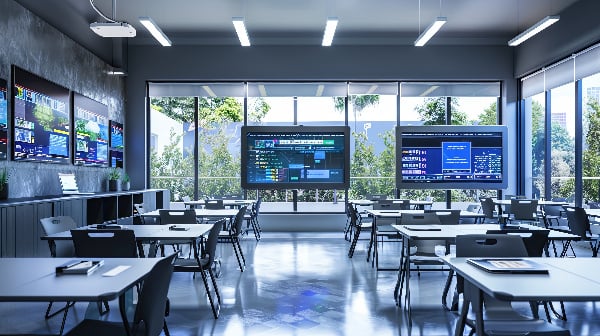Published on
Embracing Continuing Education as a Catalyst for University Growth and Innovation

Continuing education’s move to the forefront isn’t a coincidence. It can act as a bridge to programs and degrees for students, provide a direct connection to industry and boost enrollment and retention rates for the institution.
Always being a learner means always being ready for change. The challenges and opportunities we navigate daily bring us face to face with exciting new technologies, emerging fields of employment, and breathtaking discoveries. All of which come at soaring costs to keep current.
What becomes clear is that continuing education is not merely a supplementary component of our university’s offerings; it is a driving force for growth and innovation. In today’s rapidly evolving educational and professional landscape, our continuing education divisions stand at the forefront, contributing to the shape of the future of our institution.
Moving at the Speed of Business
By moving at the speed of business, we have the ability to cater to the vast and growing market of non-traditional students, like working professionals, lifelong learners, and those seeking skills enhancement. According to a 2024 report from Robert Half, 65% of technology leaders surveyed said they have a skills gap within their department, and 62% feel the skills gap has a greater impact today compared to a year ago. The nature of our work is predicated on the ability for a student to learn a skill, practice and apply it immediately. Non-traditional students spend their money and time on a course or certificate to lift themselves up, and often cannot commit to full-time degree programs—but are eager to invest in their personal and professional development.
Developing continuing education in this environment has taught us to be agile, enabling us to respond swiftly to market demands. Whether it’s emerging technologies, evolving industry standards, or new regulatory requirements, we are able to design and deliver relevant programs that keep pace with these changes.
A World Economic Forum Future of Jobs Report in 2023 found that 44% of workers core skills are expected to change in the next five years, and 61% of workers will require retraining by 2027. This responsiveness not only enhances our competitiveness but also attracts new students and fosters partnerships that can lead to further innovation.
Alternative teaching methods developed in continuing education—such as online learning, micro-credentials, and short courses—often set the stage for broader pedagogical advancements within the university. We have the ability to function as a testing zone for the university at large; it is more cost effective to try new products and services on our smaller footprint. We then share our findings with our peers and prevent costly mistakes at scale.
These innovations, initially tailored to the needs of non-traditional students, frequently spill over into our traditional programs, enhancing the overall quality of education we offer.
Pathways to Traditional Programs
Continuing education also serves as a bridge, guiding adult learners and professionals toward full-time degree programs. In 2019, 59% of the US workforce did not have a four-year degree. Many of our continuing education students eventually choose to pursue advanced degrees, thereby boosting enrollment in our traditional programs, particularly at the graduate level. This not only broadens our student base but enriches the diversity of experiences and perspectives within our classrooms.
Fostering a Culture of Lifelong Learning and Community Engagement
By promoting the value of continuous personal and professional development, we reinforce our role as a leader in education, not just for a few years of a student’s life but throughout their entire career and beyond. This approach allows us to tap into different networks, finding opportunities to provide lifetime value to the people who participate in our rich ecosystem and foster a culture of lifelong learning that extends beyond our alumni to the broader community.
A 2016 report from the National Center for Education Statistics reported of adults surveyed who had a certificate work credential, 60% reported it was very useful for getting a job, 54% said it helped keep a job, and 84% said it maintained marketability to employers or clients.
Our commitment to community engagement is another area where continuing education shines. By offering programs that address the specific needs of our local and regional communities, we strengthen our ties with the people we serve. These programs enhance our reputation and open doors to collaborations with businesses, governments, and non-profit organizations—partnerships that are vital to our institution’s growth and impact.
Small Starts Bring Large Wins
We can assist our partners inside the university with insights, experiences, even our failures. This provides critical timesaving information, data and the opportunities to try new revenue streams through certificate programs, non-credit offerings and other “outside the box” products. Information exchange enhances the quality of both our continuing education and degree programs.
Direct access to the workforce gives us the unique ability to take a pulse on how work gets done. Today, according to LinkedIn's 2024 Workplace Learning report, 90% of organizations are concerned about employee retention, and providing learning opportunities is their #1 retention strategy. By collaborating with industry leaders, we can ensure that our continuing education programs and university classes are aligned with the current needs of the workforce. We are able to provide our students with the skills and knowledge they need to succeed in their careers.
Finally, we have learned a lot about successful marketing and outreach efforts to maximize the impact of our continuing education programs. Placing small bets on multiple outreach tools such as Instagram Reels, Tik Tok, and YouTube Shorts quickly allows us to learn more about our applicant pool and students. We have applied these learnings to our Study Abroad and Summer Sessions programs, increasing our numbers. By telling the stories of our students and highlighting the success of our programs where our applicants and students are, we can attract more participants and strengthen our position as leaders in lifelong learning.
By embracing the strategies outlined above, we ensure that our continuing education programs not only contribute to our financial stability but drive our institution forward. By keeping us at the cutting edge of today’s rapidly evolving world, we fulfill our mission to provide high-quality, accessible, and relevant education to all.



